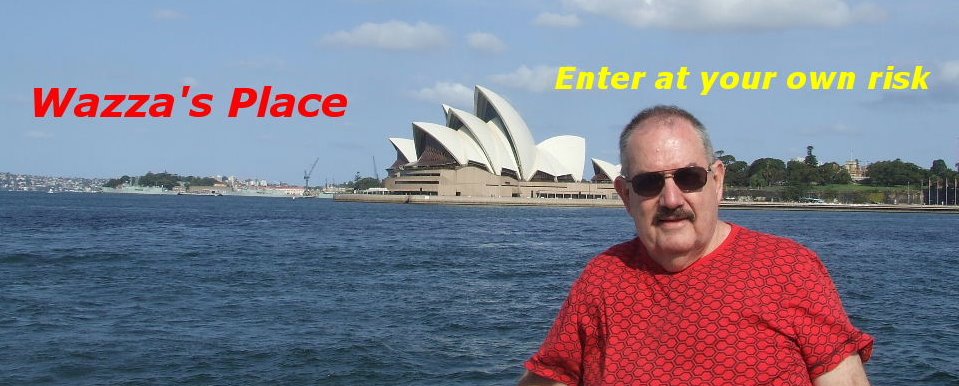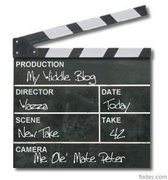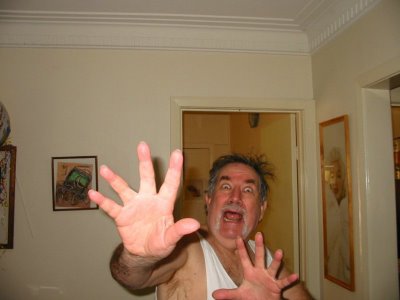Brisbane to Perth with Holtie Part 7
We departed Bell Gorge early in the afternoon for the
remainder of our journey down the Gibb River Road to
our next overnight stay at Derby about 214km away.
One of the sights we saw was a remarkable likeness of
Queen Victoria (who was born in
a natural rock formation just off the side of the road.
A remarkable likeness of Queen Victoria.
We estimated the drive into
4 hours. The road was in a fairly good condition allowing
us to travel at about 60kmh, when we drove through a
large creek. The water was running swiftly and as we
passed through the stream we heard a large bang and
the steering became difficult to handle. Peter thought we
had blown a tyre and getting out we found the rear
passenger tyre torn to shreds. Peter maneuvered the car
to the side of the road and we removed the jack from the
boot. Once we had hoisted the car up on the jack we found
that even with the jack at its highest peak we still did not
have enough height to remove the wheel. Looking around
we saw some very large rocks down a gully, which we could
put under the jack to give us a much higher lift. These rocks
were veeerrry large and it took both of us to attempt to bring
the rock up to the car. Now here we are with the rock beside
the car. The air had turned “blue” caused by a number of
words being spoken about a certain tyre, when we heard a
approaching vehicle. This happened to be a tourist truck
towing a wagon who had taken some tourists from
for a day run up to
our predicament offered us a lend of his much bigger jack.
This did “the trick” and without too much trouble we were
able to replace the wheel with the spare. Thanking the driver
Peter offered to buy him a beer next time we saw him.
“No worries mate, glad to of been a help” and with that he drove off.
One tyre that will not be repaired.
We drove into
the tent in darkness.
Sound,
differential between low and high tide reaching 11.8 metres.
In 1883 the
Secretary of State for the Colonies) was proclaimed.
The eight sheep stations in the area now had their own port
and police protection. It was also in late August of 1883 that
a shipment of wool waiting on the mudflats for delivery to a
ship was swept away by the tidal wave caused by the
Krakatoa volcanic explosion in
The jetty at Derby during low tide.
The first jetty was built in 1885 and the timing couldn’t of
been better as it was this year that Charlie Hall discovered
gold at Halls Creek and miners and prospectors poured into
the port on their way to the goldfields. The jetty ran out
across the mudflats beyond the town and the ships that
brought the miners in were only to eager to depart with
cargoes of gold, pearl shells and wool. The gold rush was
short lived and by the 1890s the port was used almost
exclusively for the export of live cattle and sheep.

The jetty at Derby is now only used by cargo vessels.
On the outskirts of town (7 km south on the
is the Boab or Baobab Prison Tree. This huge baobab tree
was used as a lockup for Aboriginal prisoners. It was the
last stopover point for patrols returning to
of holding a number of prisoners it has an entrance which is
about one metre wide and two metres high.
The boab tree in
The next day we only had about 220km to drive to Broome
which is a pearling and tourist town in the
far north of
approximately 14,000, but that grows to around 30,000
during the tourist season. Broome was first visited by
European William Dampier in 1688 and again in 1699.
Many of the coastal features of the area are named by him.
In 1879, Charles Harper suggested that the pearling industry
could be served by a port closer to the pearling grounds, and
that
selected the site for the town, and it was named after the
Governor of
One of the main streets in Broome.
We had seen the open air picture theatre in Winton
(see Part 2 of this series) and now here in Broome we were
going to see Sun Pictures. Unfortunately it wasn’t opened on
the day we were in Broome. Sun Pictures was built in 1916
and it is the world’s oldest operating open air movie theatre.
Two views of Sun Picture Theatre in Broome.
Pearling began in
luggers and more than 3500 people were fishing for shell in
waters around Broome, then the biggest pearling centre in
the world. As the divers were mostly Japanese, pearling
virtually stopped during the Second World War as they
discreetly went home or were interned and Broome was
bombed, destroying many of the remaining luggers.
Pearl luggers at Roebuck Bay, Broome
in about 1912.
In 1889, a telegraph undersea cable was laid from Broome
to
water which is washed clean every day by the 10 metre tides.
Cable Beach, Broome, 22km of white sands.
Four different views of the
Broome was attacked by Japanese aircraft on March 3, 1942.
The air raid killed at least 88 people. Not to frighten the
people of Australia, the air attack and the number of people
killed was “kept quite” by the government of the day, and it
was quite some time before it became public knowledge what
had really happened.
From about
flying boat anchorage at
Australian Air Force (RAAF) base at Broome Airfield.
No bombs were dropped, although some were reported,
perhaps due to the Zero pilots releasing their drop tanks.
The raid lasted an hour.
Mitsubishi A6M Japanese Zero Plane.
The Japanese fighters destroyed at least 24 Allied aircraft.
These included an airborne
B-24 Liberator, full of wounded personnel — more than
30 died when it crashed in the sea off Broome.
The Allies also lost 15 flying boats at anchorage.
Several months before the attack personnel from a Royal
by launch in
Half way between Broome and Port Hedland is the Sandfire
Roadhouse. It is the ONLY fuel stop in 610 kilometres of road.
Eddie Norton moved to Sandfire in May 1970. Fuel was pumped
from a 44 gallon drum. The first fuel was bartered for a carton
of beer. The roadhouse is now run by his son Ken.
....................The Sandfire Roadhouse.
News Report
Sandfire Roadhouse Burns Down
Article from: The Sunday Times
FIRE has destroyed Sandfire Roadhouse on the
Northern Hwy
The landmark travellers' stop, 2000km north of
was gutted on Wednesday afternoon when fire raced
through the building, leaving an estimated $1.5 million
damage bill. No one was injured but an accommodation
block, petrol pumps and other equipment were also
destroyed in the second fire at the roadhouse this week.
Broome detectives and fire investigators were yesterday
sifting through gutted building but say the blaze appeared
to have been caused by an electrical fault.
 Some of the big rigs that fuel up at the Sandfire Roadhouse.
Some of the big rigs that fuel up at the Sandfire Roadhouse.
Travelling south from Broome we made a quick stop at
Port Hedland. Captain Peter Hedland was one of the first
Europeans to explore the harbour for the purpose of
developing an export port. Peter Hedland arrived in the
area in April 1863 onboard his boat "Mystery" that he had
built himself at Point Walter on the banks of the
Port Hedland is another massive port on the Western
Australian coast exporting the Pilbara's extensive iron ore
deposits. So huge is the operation that 2.6 kilometre long
trains haul their loads into shipping yards nine times a day.
The train is hauled by six locomotives (3 pairs throughout
the length of the train).
Port Hedland is a natural deep anchorage port that as well as
being the main fuel and container receival point for the region
was seen as perfect for shipment of the iron ore being mined
in the ranges located inland from the town. The ore is moved
by railway lines from four major iron ore deposits to the east
and south of Port Hedland.
Leaving Port Hedland, traveling further south we detoured
off the main highway 11 km to Point Samson a small sleepy
tourist town that is a popular holiday location for the nearby
mining towns, including Karratha and Dampier. Fishing is the
main industry. Here we decided to try our luck at fishing.
We spent a couple of hours fishing off a jetty and were
rewarding with a number of catches.
Peter fishing at Point Samson.
Our next port of call was Carnarvon which is a coastal
town situated approximately 900 km north of
a population of about 7000. The town was founded in 1883
and it lies at the mouth of the
Ocean
flows unseen below the surface of the riverbed. The rich
irrigated soils are well know for the production of huge crops
of bananas, water melons and tomatoes. We decided to have
pizza for our evening meal. Across the road where we had
camped was a Caltex Service Station and there was a Pizza
Haven in the café. This would have been the worst pizza we
had ever eaten, cardboard with tomato topping would of
tasted better. Hey maybe we ate the box instead of the pizza.
Nah, the box proberly would of tasted better too?
The Carnarvon Tracking Station in
tracking station used by NASA. It was built in 1963 for the
Gemini program, the second step for NASA's plan to put a
human on the Moon. After the conclusion of the Gemini
program, Carnarvon Tracking Station provided extensive
support for the Project Apollo missions to the Moon.
Carnarvon Tracking Station now closed down.
In Part 8 we travel onto one of the prettiest towns on the
west coast, Kalbarri, and then onto Geraldton for one of the
saddest wartime stories about the loss of HMAS

















.jpg)









6 comments:
I'm repaying you the favour by being first cab off the rank in your blog, too, Wazza! ;)
Again terrific pics and a wonderfully interesting and informative story. Thanks for sharing these memories with us.
(Btw...I posted up on my last post in my blog some pics of myself between the ages of 14-26...seeing you mentioned pics! It's all your fault and you're to blame!) ;)
Another leg of our epic adventure Wazza,
you have certainly researched your subject well mate.
Hi Warren ~~ Another great episode in that trip. Lots of great photos and
the usual info. I guess they will rebuild that Sandfire Roadhouse
again if they haven't already. The beaches at Broome look wonderful, and I liked the very old boab tree.
Thanks for sharing all these stories with us. Take care Warren, Regards,
Merle.
Hi Warren another very enjoyable read with great photos. A friend of mine at Gympie's husband used to fly those flying boats. Have not been able to come up with any more possible on site chefs I am afraid.
Cheers margaret
I think this one is the best yet!
That Queen Victoria was my relative, we 'think.'
Jim's Little Blog will be operated by Karen and/or Billy until mid-June.
I will try to find an Internet cafe in the jail house so I can check in every now and then.
..
Sure sounds like a memorable trip, with sooooo many things to see. Thanks for sharing.
As I've said before, this is a wonderful country ... I want to see more of it.
Take care, Meow
Post a Comment